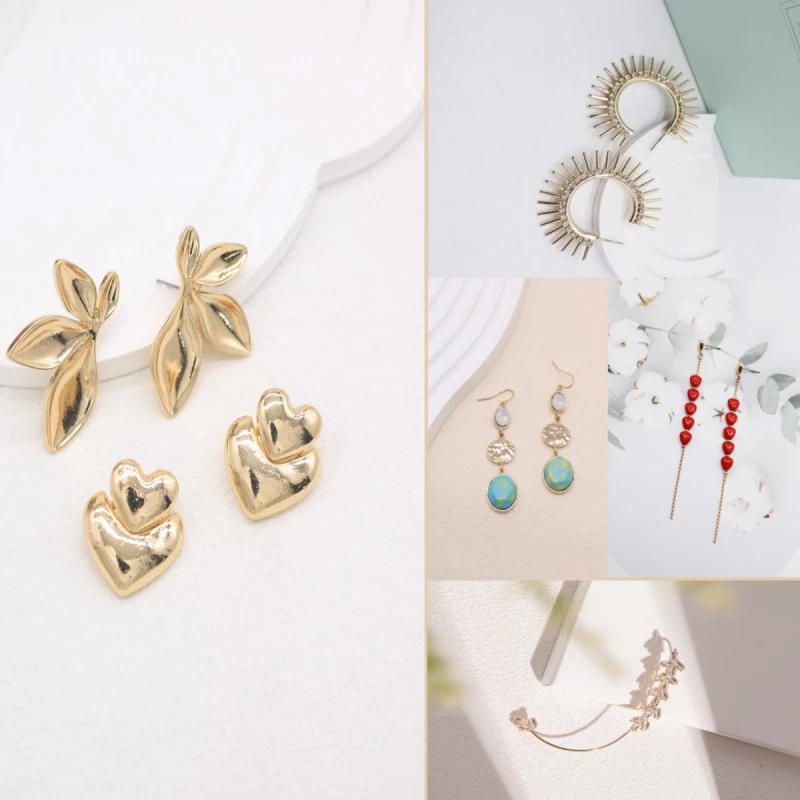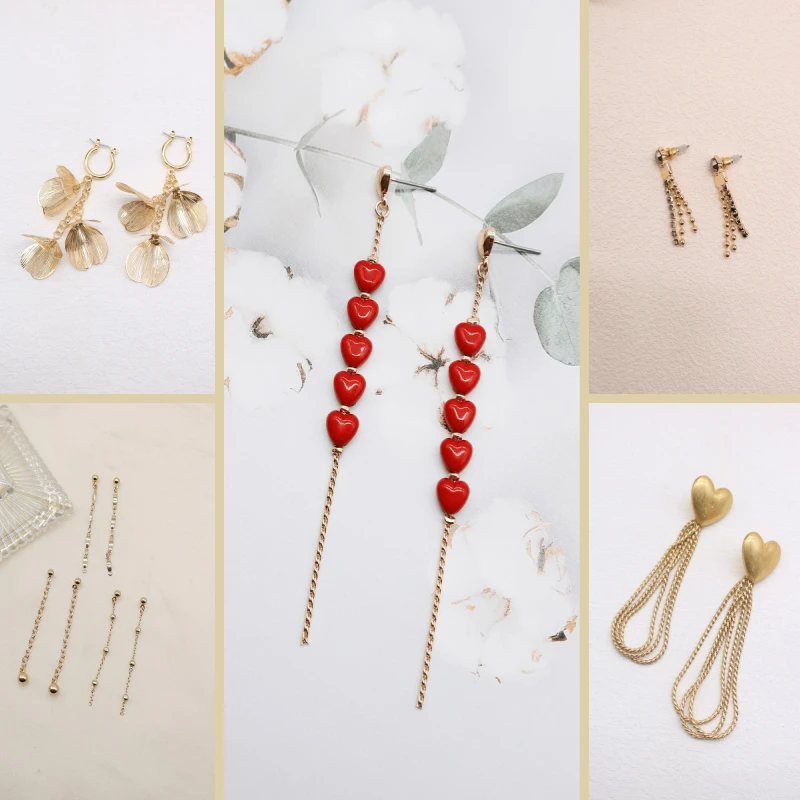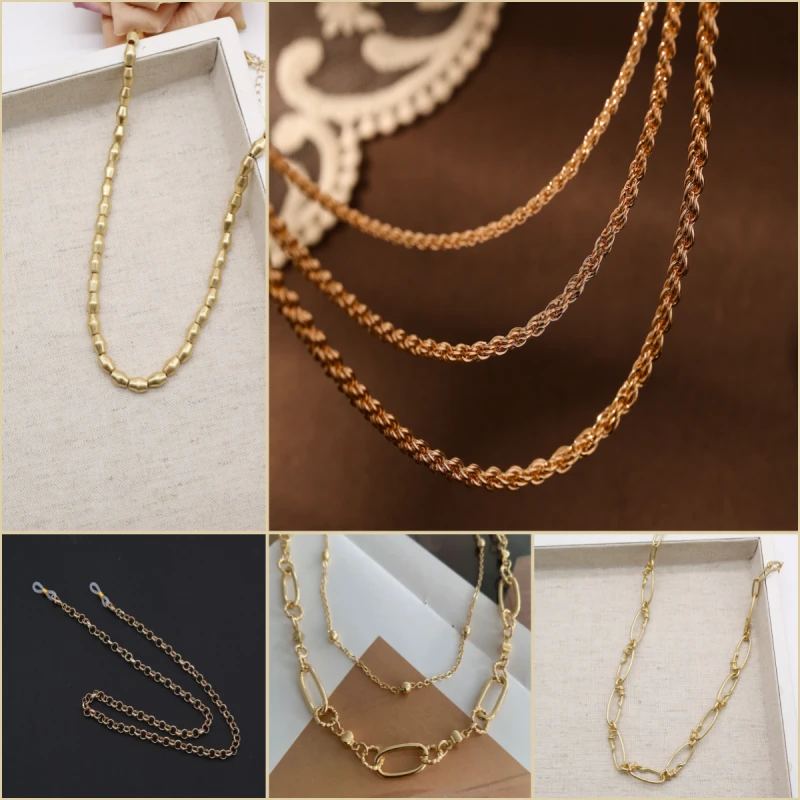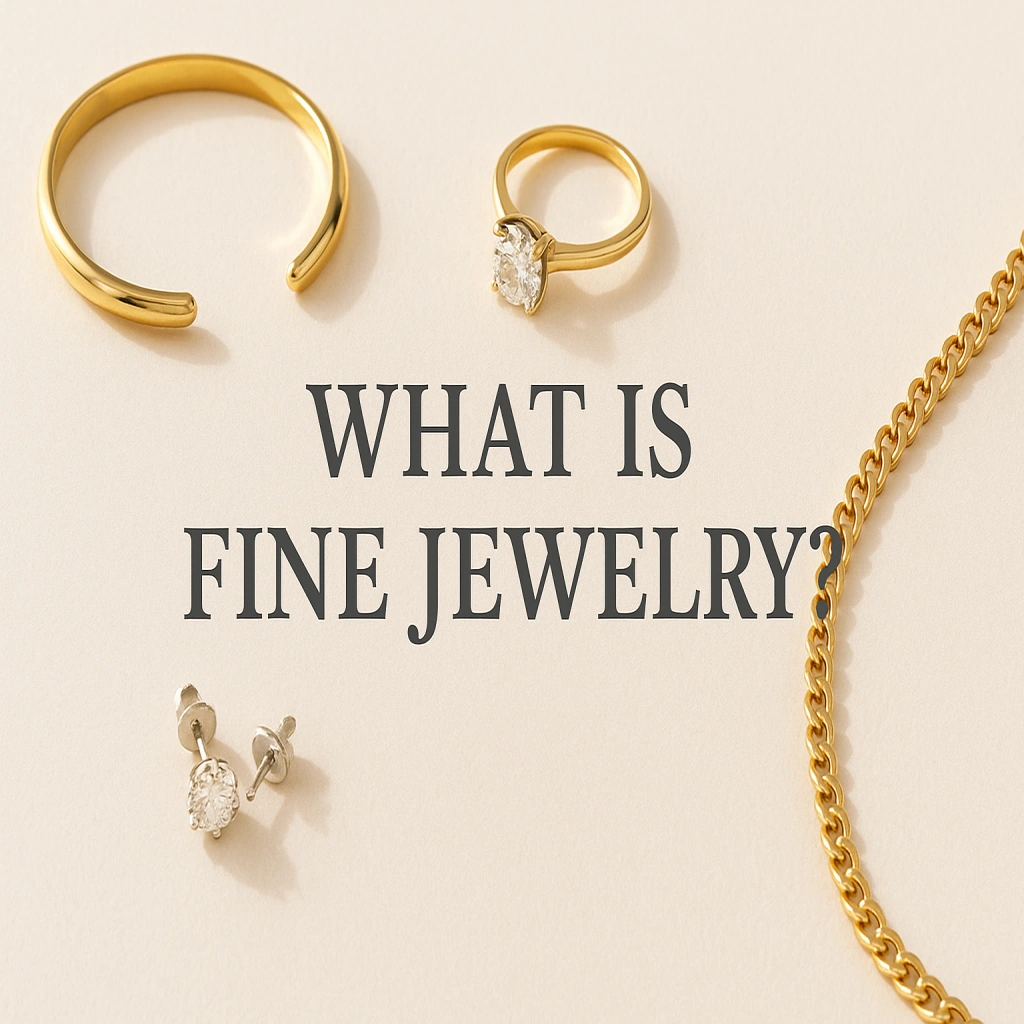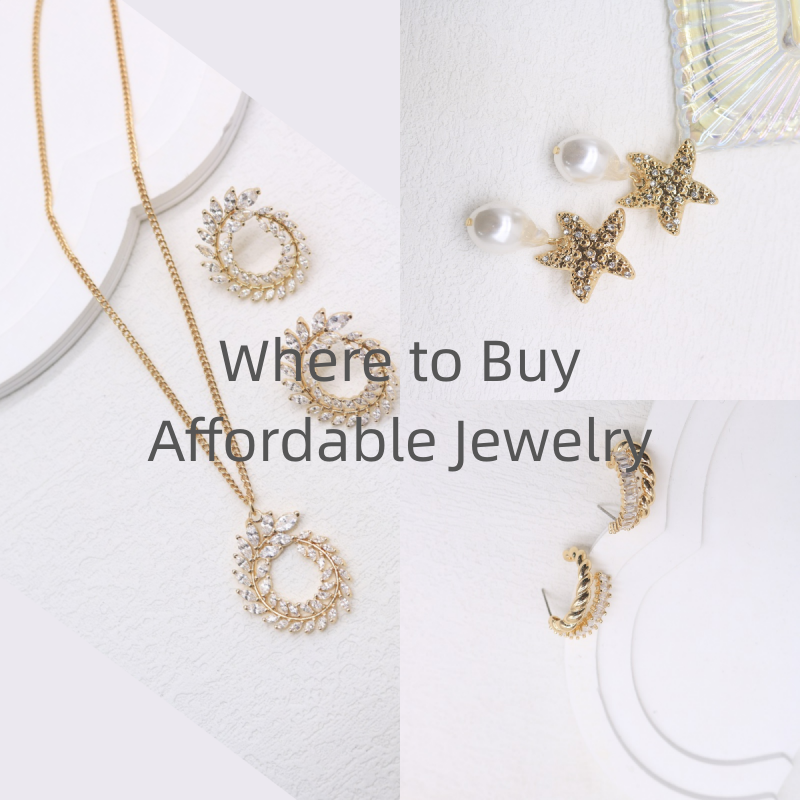When shopping for jewelry — whether online, in a boutique, or directly from a supplier — you’ll often see two main categories: fashion jewelry and fine jewelry.
At first glance, both can look stunning. But under the surface, they’re made from very different materials, have different price points, and even serve different purposes.
So, what’s the real difference between fashion jewelry and fine jewelry? And if you’re a buyer or retailer, which should you invest in?
Let’s break it all down in simple terms.
1. What Is Fashion Jewelry?
Fashion jewelry, also called costume jewelry, is made primarily for style and affordability rather than long-term value.
It’s designed to help people keep up with fashion trends — bold colors, modern shapes, and eye-catching designs — without breaking the bank.
Common Materials Used in Fashion Jewelry
Base metals: brass, copper, or alloy
Plating: gold-plated, silver-plated, or rhodium-plated
Stones: glass, rhinestones, cubic zirconia, or acrylic
Other elements: resin, plastic, or fabric
Fashion jewelry is all about creative design and accessibility.
You can find beautiful necklaces, earrings, bracelets, and rings that look luxurious but cost a fraction of fine jewelry.
Pros of Fashion Jewelry
✅ Affordable — perfect for daily wear or short-term trends
✅ Lightweight and comfortable
✅ Available in endless colors and styles
✅ Great for experimenting with different looks
Cons of Fashion Jewelry
Not made to last forever (plating can fade over time)
Can cause allergies if low-quality metals are used
Low resale or investment value
In short, fashion jewelry is style-driven and budget-friendly. It’s perfect for fashion lovers and retailers targeting the mass market.
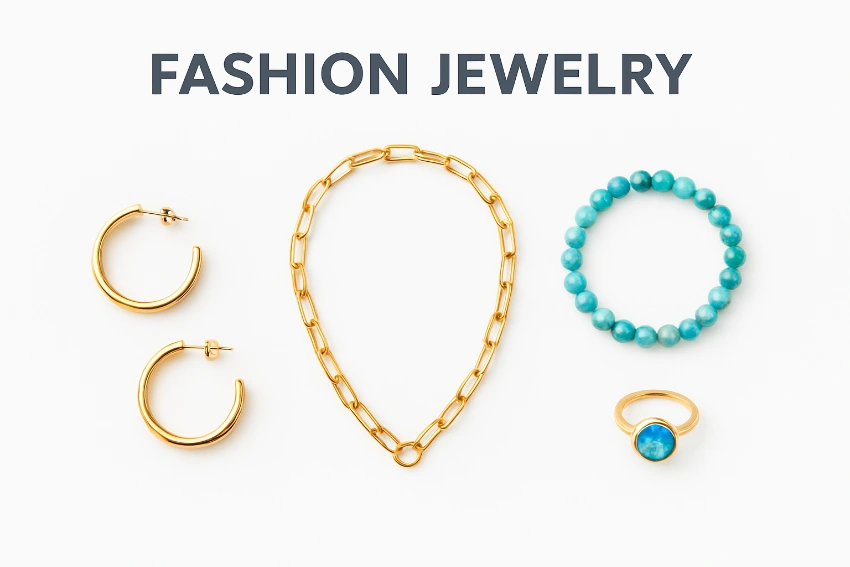
2. What Is Fine Jewelry?
Fine jewelry is made from precious metals and genuine gemstones — such as gold, silver, platinum, diamonds, sapphires, or emeralds.
These pieces are designed to last a lifetime, often passed down through generations.
Common Materials Used in Fine Jewelry
Metals: 14K, 18K, or 24K gold; sterling silver; platinum
Gemstones: diamonds, rubies, emeralds, sapphires, pearls
Craftsmanship: precision hand-setting and polishing
Pros of Fine Jewelry
✅ Long-lasting and durable
✅ Retains value or may appreciate over time
✅ Hypoallergenic (especially gold and platinum)
✅ Perfect for gifts, weddings, or heirlooms
Cons of Fine Jewelry
More expensive upfront
May require special care or storage
Limited in trend-driven styles
Fine jewelry is for luxury buyers, collectors, and those who value timeless elegance.
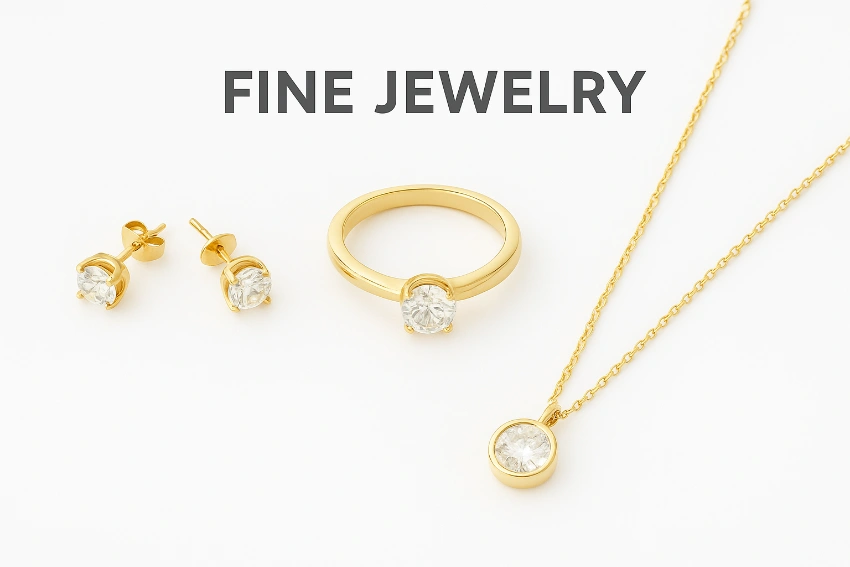
3. The Core Differences Between Fashion Jewelry and Fine Jewelry
Here’s a quick side-by-side comparison:
| Feature | Fashion Jewelry | Fine Jewelry |
|---|---|---|
| Main Materials | Base metals (brass, copper) + plating | Precious metals (gold, silver, platinum) |
| Stones | Glass, resin, CZ | Genuine gemstones, diamonds |
| Durability | Short-term, may tarnish | Long-lasting, heirloom quality |
| Price Range | Affordable ($5–$100) | Premium ($200–$10,000+) |
| Purpose | Trend, daily fashion | Luxury, gifting, investment |
| Maintenance | Easy but limited lifespan | Requires cleaning, safe storage |
| Market Segment | Mass-market | High-end or luxury market |

4. How to Choose: Fashion Jewelry vs Fine Jewelry
Choosing between the two depends on your goal, budget, and lifestyle.
If You’re a Fashion Lover
Go for fashion jewelry. It allows you to:
Try new styles without spending too much
Mix and match colors and materials
Stay up-to-date with seasonal trends
Tip: Choose pieces with nickel-free plating or stainless steel bases to avoid skin irritation.
If You Want Long-Term Value
Choose fine jewelry. It’s perfect for:
Special occasions (weddings, anniversaries)
Gifts that hold sentimental or material value
Building a jewelry collection that lasts decades
Tip: Always ask for a certificate of authenticity for diamonds and precious metals.
5. Buying Tips for Consumers
A. Check the Material Details
For both types, materials matter.
Fashion jewelry should mention plating thickness or nickel-free materials.
Fine jewelry should list metal purity (e.g., 18K gold) and gem authenticity.
B. Read Reviews and Brand Transparency
If you’re buying online, check if the brand clearly lists its material sources.
Honest labeling means better quality control.
C. Match Your Lifestyle
If you often wear jewelry to work or travel, fashion jewelry might be better since you won’t worry about loss or damage.
If you prefer fewer, high-quality pieces — fine jewelry fits your lifestyle better.
6. Buying Advice for Jewelry Business Owners or Wholesalers
If you’re in the jewelry business, understanding the two categories is crucial.
A. Source Fashion Jewelry from China for Cost Efficiency
China is one of the largest producers of fashion jewelry, offering:
Factory-direct prices
A wide range of plating and design options
OEM & ODM customization
Fast turnaround for bulk orders
✅ Tip: When sourcing from China, look for factories with nickel-free, lead-free, and cadmium-free certifications to meet EU and U.S. standards.
B. For Fine Jewelry, Focus on Small-Batch Quality
While China and India produce fine jewelry, quality control and certification are key.
If you sell fine jewelry, prioritize:
Reliable gemstone suppliers
Precious metal authenticity (ask for certificates)
Consistent craftsmanship
Some brands even combine fine metal bases with fashion jewelry designs — creating a mid-range collection that’s trendy yet durable.
C. Consider Market Positioning
Ask yourself:
Who is my target audience?
Do I sell to trend-driven consumers or luxury buyers?
What’s my average price point per piece?
Fashion jewelry = high volume, lower margin, faster trend cycles.
Fine jewelry = lower volume, higher margin, slower but consistent sales.
7. How to Combine Fashion & Fine Jewelry in One Brand
Many successful brands today mix both.
They sell fashion jewelry to attract young buyers — and fine jewelry to retain long-term clients.
Example:
Offer a $20–$50 plated necklace collection for everyday wear
Pair it with a $500 gold-and-diamond line for special occasions
This approach lets you serve a wider customer base while maintaining brand identity.
8. Caring for Your Jewelry
For Fashion Jewelry
Keep away from water and perfume
Wipe with a soft cloth after each use
Store in a dry, cool place
For Fine Jewelry
Clean regularly with mild soap and warm water
Store in individual soft pouches
Avoid harsh chemicals or ultrasonic cleaners for pearls and soft stones
9. The Future Trend: Sustainable Jewelry
Consumers today care about eco-friendly materials and ethical sourcing.
More factories now use:
Recycled metals
Lab-grown diamonds
Eco-friendly plating methods
This shift benefits both the fashion and fine jewelry industries, making sustainability a major trend for the next decade.
Conclusion
To sum up:
Fashion jewelry is about style, affordability, and creativity.
Fine jewelry is about quality, longevity, and timeless value.
If you love experimenting with looks — go for fashion jewelry.
If you want to invest in lifelong pieces — choose fine jewelry.
And if you’re a business owner, you don’t have to pick just one. Many brands successfully offer both categories to meet different customer needs.
Whether you’re buying or sourcing, understanding the differences between fashion jewelry vs fine jewelry helps you make smarter decisions — and find the right balance between style, quality, and price.

